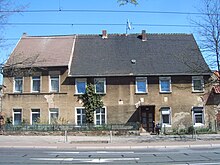Weibezahlscher Hof
The Weibezahlsche Hof is a listed former farm in the Magdeburg district of Westerhüsen .
History and architecture
The farm was built around the year 1600 and was called Freihof and later Stöfflerscher Hof , although the buildings that still exist today may have been built later. The construction of the two-storey house that still exists today is dated to the year 1859. Other sources assume that it was formed around the first third of the 19th century. The house was made of plastered quarry stone masonry . The building, located directly on the main street Alt Westerhüsen (house number 153), has a large archway on both sides of the main street as access to the courtyard.
Noteworthy is a cannonball walled into the facade, which may have been taken over from the previous building. An inscription stone bears the year 1631 there. The cannonball reminds us that the general Johann T'Serclaes von Tilly had his headquarters in this courtyard during the siege and destruction of Magdeburg in 1631 . Two more cannonballs were originally on the farm buildings. Several letters from Tilly have come down to us that were written during this period. On the evening of May 9, 1631, Tilly held the council of war here , at which the storm on Magdeburg, which led to the destruction of the city, was set for May 10. On June 5, 1631, Tilly then withdrew from Westerhüsen.
On August 30, 1669, Martin Friedrich Curio , pastor at the Sankt-Stephanus-Kirche in Westerhüsen , leased the property from Peter Biltzing for six years . After the brewer and citizen of Magdeburg, Johann Stoeffler , married the daughter of a mayor from Alsleben on January 16, 1710 , he acquired the estate including one and a half hooves and set up a brandy distillery . In addition, he acquired the two-and-a-half hooves originally located at today's Kieler Strasse 4 . Presumably, the Stoeffler family leased additional arable land over the years. He died on October 1, 1760. His son Johann Andreas Stoeffler , born on August 4, 1732, married the daughter of a Schönebeck bailiff on November 20, 1760 . He handed over the farm in 1792 to his only son Johann Gottfried Stoeffler , who was born on September 17, 1761 and was mayor of Westerhüsen from 1820. It is documented by Johann Gottfried Stöffler that he climbed the Brocken in the Harz Mountains on October 7, 1788 and entered himself into the Brocken register.
On May 30, 1809, an accident occurred, probably right outside the door of the courtyard. When French troops were passing through , a shot went off from a rifle lying across on a wagon and hit the eleven-year-old Katharine Elisabeth Wedenstedt , who was just standing in front of Adjunct Stoeffler's door . The shot went through the girl's right loin . The girl survived but remained limping. Johann Friedrich Wedenstedt , the girl's father, could not afford the 40 thalers cost of the lengthy treatment. After the treatment costs had been reduced to 33 thalers and 10 groschen, half of the amount was raised through a collection. It is recorded that the child's further life path was that in 1822 she married a man from Görzke .
Johann Gottfried Stoeffler gave up the distillery after a while. Presumably during this time he erected the older southern part of the current building. Johann Gottfried Stoeffler died on December 3, 1835. The farm was taken over by his son Johann Wilhelm Christoph Stoeffler , born on November 14, 1803 . In 1836 he had the large arches that still exist today built and significantly enlarged the economy. He acquired another five farms and incorporated the arable land into his yard. After the separation , which was favorable for him , he owned 474 acres of land. After the death of his only son, however, he increasingly leased arable land to the sugar factory . Stoeffler died on February 8, 1882. The farm was continued by his son-in-law Ernst Weibezahl , to whom the name of the property goes back. He tore down a large part of the farm buildings.
literature
- Heinz Gerling , Monuments of the City of Magdeburg , Helmuth-Block-Verlag, Magdeburg 1991, ISBN 3-910173-04-4 , page 32
- List of monuments Saxony-Anhalt, Volume 14, State Capital Magdeburg , State Office for Monument Preservation and Archeology Saxony-Anhalt, Michael Imhof Verlag, Petersberg 2009, ISBN 978-3-86568-531-5 , page 57
- Westerhüsen's administration in the Napoleonic era in the Evangelisches Gemeindeblatt Magdeburg-Westerhüsen, between 1924 and 1942
Individual evidence
- ↑ Gerling, Monuments, page 32
- ^ List of monuments, Magdeburg, page 57
- ^ Westerhüsen's administration during the Napoleonic period in Evangelisches Gemeindeblatt, between 1924 and 1942
- ^ List of monuments, Magdeburg, page 57
- ^ Friedrich Großhennig, Ortschronik von Westerhüsen in the city district of Magdeburg-SO , manuscript in the Magdeburg city archive, signature 80 / 1035n, Part II, page 5; Dates according to the Julian calendar , according to today's calendar, the council of war took place on May 19th, the storming on May 20th
- ↑ Yearbooks of the Brocken from 1753 to 1790 , with Johann Adam Creutz Magdeburg 1791, page 206, [1]
- ↑ Friedrich Großhennig, Ortschronik von Westerhüsen in the city district of Magdeburg-SO , manuscript in the Magdeburg city archive, signature 80 / 1035n, Part II, page 38
Coordinates: 52 ° 3 ′ 53.7 " N , 11 ° 40 ′ 37.4" E


